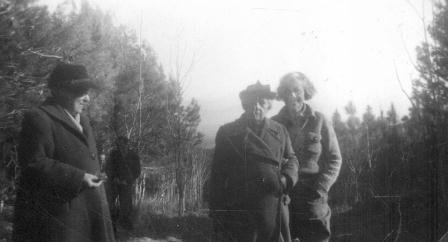Like an outsider looking in
Irma (Rama) Lindheim was born on 1886 in New York. Her father was a successful business man who had become wealthy, and the family lived a comfortable life padded with everything money could buy. Lindheim's childhood passed with little connection to Judaism – the Lindheim family was secular and didn't celebrate the Jewish holidays. In the autobiography she would write years later, she would say that as a child she felt disconnected, like an outsider looking in, and lacked a sense of tradition. She would also write about a lonely childhood, because of the heavy stuttering she suffered from as a child. To compensate for all of these, she immersed herself in her studies, in which she excelled.
Her intellectual curiosity and search for roots, part of a never ending process of soul searching that would characterize her all her life, led her to take a keener interest in Judaism, and late in Zionism as well. At the age of 31 she became an avid Zionist and from that point on she dedicated herself to the Zionist movement. But before that, Irma Lindhiem went to war.
Uncle Sam wants you
In 1917 the United States faced a choice – either watch its allies be continuously defeated on the Western Front , or become an active player in the new theater of total war. Entering WWI required the Unites States to mobilize unprecedented forces, and women took an active part in the effort. One such woman was Lindheim, who joined the US Motor Corps – with her Cadillac. She was the first Jewish woman to become a first lieutenant in the USMC. At that time, she was already a mother of four.
One glass ceiling at a time
After returning from the war, Lindheim dedicated her all to Zionism. With the money she inherited after her father passed away, she financed a center for the Zionist Organization in America, in New York. She also became one of the most sought after speakers of the Organization in the United States. Her interest in Judaism increased alongside her Zionist activities, and in 1922 she enrolled in the Jewish Institute of Religion in New York, becoming the first woman to study at the Institute. During her studies she broke another glass ceiling: as a woman, she was not allowed to participate in the rabbinical course and qualify as a rabbi. She petitioned to the faculty of the institute in order to change this regulation. Lindheim herself left the Institute before completing her studies in order to devote more time to her Zionist activities, but because of her petition, the Institute decided to open its studies to women and men on an equal basis.
A new beginning in the middle of life
The decisions to become a driver in the army, and later, an ordained rabbi, seem unusual for a woman in the 1920's, but conformity was not something Lindheim practiced. After leaving her studies, she continued to move to the forefront of Zionist leadership in the US. In 1926 she became the third president of Hadassah, after Henrietta Szold left office. She also became the vice-president of the Zionist Organization of America. As president of Hadassah, Lindheim strove to have the organization promote aliya, as opposed to Szold, who focused more on education.

In the early thirties, the time came for another unusual decision in the life of Lindhiem. After her husband, Norvin, passed away, Lindheim, then aged 47 and a mother of five, decided to leave her comfortable life in New York and move with her children to Palestine. These were also the years of the ideological rift between Lindheim and Hadassah – she became more radical and criticized the organization, which she found to be too conservative. She did not accept an offer to serve a second term as the president of Hadassah, and became more affiliate with Hashomer Hatsair.
The grandmother of the kibbutzim
Lindheim settled in Kibbutz Mishmar Ha’emek, and replaced her large Long Island mansion with a small hut that cost $27 to build. "Rama's hut" became a byword at Mishmar Ha’emek, and everyone knew the enthusiastic pioneer, who was 20 years older than the rest of the kibbutz members, and who carried out her kibbutz tasks dressed in elegant attire.
Throughout her life, Lindheim remained active in fund-raising and campaigning for the Zionist Movement in the United States. She helped establish the first American kibbutz - Ein Hashofet – and became known in the Israeli media as "the grandmother of the kibbutzim".